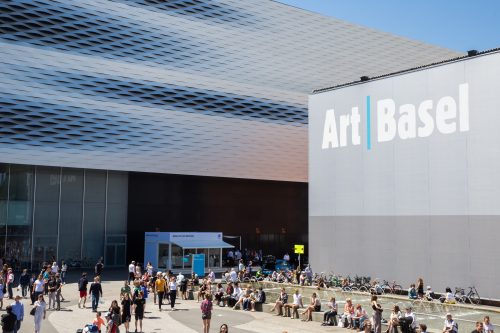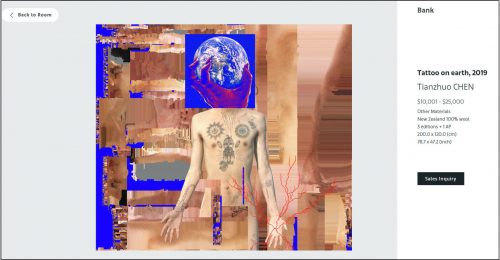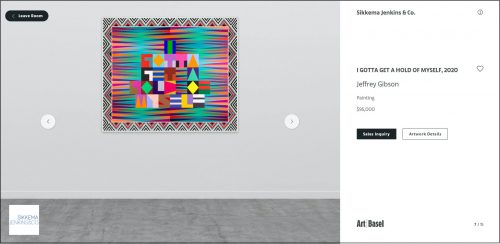DMI founder and CEO Sunny Bajaj describes the critical new role technology is playing in viewing and purchasing works at Art Basel

© Art Basel
Courtesy Art Basel
With Art Basel entering into its 50th year of operation, something had to be done to keep the highly-anticipated and annual fair alive when the Hong Kong fair was canceled due to COVID-19. Quickly, the tech world came to the rescue. In March 2020, while the pandemic was on the rise, Art Basel turned to its trusted digital partner, Bethesda, Md.-based DMI, founded and run by Sunny Bajaj, to introduce its first Online Viewing Rooms. Over 2,000 works from more than 230 galleries with an estimated value of 0 million were made available to collectors, buyers and enthusiasts online.
Now, new June Online Viewing Rooms running through this Friday, June 26, are doubling the works online — offering 4,000 works from 282 international art galleries with help of enhancements made by DMI. We spoke with Bajaj about the trend of virtual art fairs, who says that “art has no boundaries” to learn more about online art presentations, how the industry has adopted, and DMI’s role in the intersection of technology and art.
WL: Tell us more about DMI’s role in digital experiences in the art world.
Bajaj: DMI specializes in creating transformational mobile and digital experiences and we’ve had a longstanding and trusted partnership with Art Basel. It had always been part of the vision to incorporate a digital element for Art Basel but the pandemic accelerated that sense of urgency and fortunately our team was ready.
When Art Basel’s Hong Kong edition moved online, it marked a turning point. The virtual space of a publicly accessible, timed, online event was new territory for many of Art Basel’s 233 participating galleries.
It has been enormously gratifying for DMI to develop the digital platform. Online Viewing Rooms are a trend we only see growing as the art community becomes more accustomed to a digital approach.
… Digital platforms cannot replace the experience of viewing and appreciating art in a physical sense. But not everyone is able to visit Miami, Hong Kong or Switzerland.
buy zydena online https://thefixaspen.com/wp-content/uploads/2024/08/jpg/zydena.html no prescription pharmacyonline pharmacy buy spiriva online with best prices today in the USADigital offers an exciting additional channel for galleries to present their works to a much broader international audience.” – Sunny Bajaj

DMI CEO Sunny Bajaj at the company headquarters in Bethesda Maryland. Photo by Hubbard Productions © Garrett Hubbard 2012
WL: How is technology revolutionizing how art collectors can view and purchase art during the pandemic and beyond?
Bajaj: Art knows no boundaries. We strongly believe that digital platforms cannot replace the experience of viewing and appreciating art in a physical sense. But not everyone is able to visit Miami, Hong Kong or Switzerland. Digital offers an exciting additional channel for galleries to present their works to a much broader international audience. It is exciting to see the art world largely acclimate to the shift online, especially when it comes to offering high-value works to buyers virtually. Initial reports from the June fair indicate sales have been brisk.
WL: Art Basel’s Online Viewing Rooms in March presented over 2,000 works from more than 230 galleries. In your view, what is the future of art fairs?
Bajaj: We see the online component only continuing to drive more global interest and engagement in art. That said, we firmly believe that digital platforms cannot replace the overall experience of viewing art in person or physically visiting and experiencing art galleries and fairs. The pandemic has presented a unique opportunity to transition from a purely physical event to an online approach. We’re at an inflection point and people are open to trying out new channels. Interest level is high and we only see that growing as the art community becomes more accustomed to appreciating and purchasing art in this way.
Online Viewing Rooms are a trend we only see growing as the art community becomes more accustomed to a digital approach.” – Sunny Bajaj
WL: What is DMI’s proudest accomplishment in terms of the company’s ongoing 5-year relationship with Art Basel?
Bajaj: DMI values our relationship with Art Basel and our team works closely with the organization’s Digital Director, Alban Fischer. In terms of our partnership, two moments stand out. First, the development of Art Basel’s mobile app in 2015, which we’ve continued to make enhancements to in the years since. Then, I would have to say, the launch of the Online Viewing Rooms. It is thrilling to see so much industry adoption that’s happened within one year. Online Viewing Rooms are a new norm. Even when physical fairs resume, online will surely be a critical part of the experience.

Courtesy of Art Basel
WL: What more do you want people to understand about the role that technology is playing for art galleries on a global scale? (Related general question… why does art need technology, and why does technology need art?
Bajaj: Technology is playing an increasingly important role in all of our lives, and it’s exciting to see its growing impact in the art world. Digital art and video art have become increasingly popular in recent years, and artists are leveraging these mediums to create many innovative works.
Technology is also expanding access to art. More museums and galleries are now leveraging technology to help people learn about art through interactive maps, videos about exhibits, audio tours and more.

Courtesy of Art Basel
WL: Any favorite works of art in the galleries?
Bajaj: What is so intriguing for me is the enormous range of works presented the Online Viewing Rooms. Art from the modern to post-war and contemporary periods are showcased, including paintings, drawings, sculptures, photography, installation, digital and video works. I can’t say I have a favorite but it is gratifying to see each medium brought to life through a digital platform that successfully inspires all who visit.
